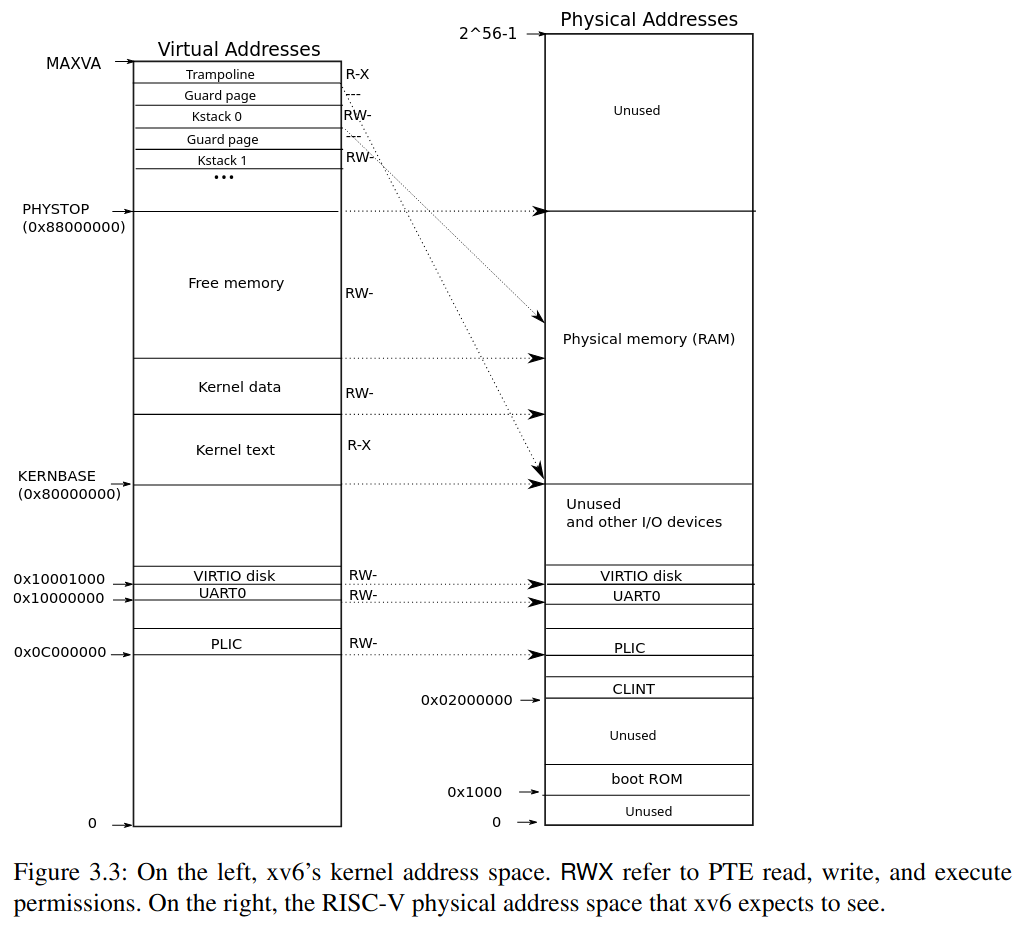Initialize#
kernel/main.c: main()
kernel/pci.c: pci_init()kernel/e1000.c: e1000_init(uint32 *xregs)
kernel/sysnet.c: sockinit()
kernel/pci.c: pci_init()
void
pci_init()
{
// we'll place the e1000 registers at this address.
// vm.c maps this range.
// 我們會把 e1000 registers 放到這個位置
// 如下圖,他會被放在 unused and other I/O devices 的區塊
// vm.c 會負責做這個 mapping
uint64 e1000_regs = 0x40000000L;
// qemu -machine virt puts PCIe config space here.
// vm.c maps this range.
// 這裡則是在 mapping PCIe config
// 跟前面一樣,是放在 unused and other I/O devices 的區塊
// ECAM for Extended Configuration Access Mechanism
uint32 *ecam = (uint32 *) 0x30000000L;
// look at each possible PCI device on bus 0.
// bus == 0 是固定的,只掃描 Primary Bus
// dev: 0 ~ 31 設備號碼,每一個代表一個獨立設備例如 E1000 網卡、顯示卡,現在要尋找 E1000
// func: 功能號碼,每一個設備可以有多個 function, 這裡只需要尋找第 0 個功能,E1000 也只有一個功能
// offset: 指向配置空間中特定 4 位元組暫存器的偏移量, 設為 0
// off: 透過上面的資訊取得總 offset
for(int dev = 0; dev < 32; dev++){
int bus = 0;
int func = 0;
int offset = 0;
uint32 off = (bus << 16) | (dev << 11) | (func << 8) | (offset);
volatile uint32 *base = ecam + off;
uint32 id = base[0];
// 100e:8086 is an e1000
if(id == 0x100e8086){
// command and status register.
// bit 0 : I/O access enable
// bit 1 : memory access enable
// bit 2 : enable mastering
base[1] = 7;
__sync_synchronize();
for(int i = 0; i < 6; i++){
uint32 old = base[4+i];
// writing all 1's to the BAR causes it to be
// replaced with its size.
base[4+i] = 0xffffffff;
__sync_synchronize();
base[4+i] = old;
}
// tell the e1000 to reveal its registers at
// physical address 0x40000000.
base[4+0] = e1000_regs;
e1000_init((uint32*)e1000_regs);
}
}
}

kernel/e1000.c: e1000_init(uint32 *xregs)
// called by pci_init().
// xregs is the memory address at which the
// e1000's registers are mapped.
void
e1000_init(uint32 *xregs)
{
int i;
initlock(&e1000_lock, "e1000");
regs = xregs;
// Reset the device
regs[E1000_IMS] = 0; // disable interrupts
regs[E1000_CTL] |= E1000_CTL_RST;
regs[E1000_IMS] = 0; // redisable interrupts
__sync_synchronize();
// [E1000 14.5] Transmit initialization
memset(tx_ring, 0, sizeof(tx_ring));
for (i = 0; i < TX_RING_SIZE; i++) {
tx_ring[i].status = E1000_TXD_STAT_DD;
tx_mbufs[i] = 0;
}
regs[E1000_TDBAL] = (uint64) tx_ring;
if(sizeof(tx_ring) % 128 != 0)
panic("e1000");
regs[E1000_TDLEN] = sizeof(tx_ring);
regs[E1000_TDH] = regs[E1000_TDT] = 0;
// [E1000 14.4] Receive initialization
memset(rx_ring, 0, sizeof(rx_ring));
for (i = 0; i < RX_RING_SIZE; i++) {
rx_mbufs[i] = mbufalloc(0);
if (!rx_mbufs[i])
panic("e1000");
rx_ring[i].addr = (uint64) rx_mbufs[i]->head;
}
regs[E1000_RDBAL] = (uint64) rx_ring;
if(sizeof(rx_ring) % 128 != 0)
panic("e1000");
regs[E1000_RDH] = 0;
regs[E1000_RDT] = RX_RING_SIZE - 1;
regs[E1000_RDLEN] = sizeof(rx_ring);
// filter by qemu's MAC address, 52:54:00:12:34:56
regs[E1000_RA] = 0x12005452;
regs[E1000_RA+1] = 0x5634 | (1<<31);
// multicast table
for (int i = 0; i < 4096/32; i++)
regs[E1000_MTA + i] = 0;
// transmitter control bits.
regs[E1000_TCTL] = E1000_TCTL_EN | // enable
E1000_TCTL_PSP | // pad short packets
(0x10 << E1000_TCTL_CT_SHIFT) | // collision stuff
(0x40 << E1000_TCTL_COLD_SHIFT);
regs[E1000_TIPG] = 10 | (8<<10) | (6<<20); // inter-pkt gap
// receiver control bits.
regs[E1000_RCTL] = E1000_RCTL_EN | // enable receiver
E1000_RCTL_BAM | // enable broadcast
E1000_RCTL_SZ_2048 | // 2048-byte rx buffers
E1000_RCTL_SECRC; // strip CRC
// ask e1000 for receive interrupts.
regs[E1000_RDTR] = 0; // interrupt after every received packet (no timer)
regs[E1000_RADV] = 0; // interrupt after every packet (no timer)
regs[E1000_IMS] = (1 << 7); // RXDW -- Receiver Descriptor Write Back
}
